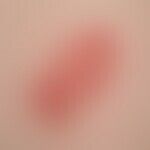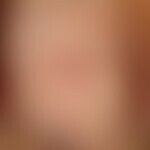Synonym(s)
HistoryThis section has been translated automatically.
DefinitionThis section has been translated automatically.
Keratinocyte-derived, mostly solitary carcinoma in situ of the skin (see also carcinoma kutanes), clinically characterized by a slowly growing, red plaque with scaly or scaly-crusty, rarely smooth, red or red-brown surface. When occurring on the genital mucosa, Bowen's disease is called erythroplasia.
You might also be interested in
EtiopathogenesisThis section has been translated automatically.
ManifestationThis section has been translated automatically.
Occurs in older people (> 60 years), preferably in fair-skinned people. However, this does not apply to cases which are intertriginous and in the genito-anal region.
LocalizationThis section has been translated automatically.
Possible on the entire integument; especially light-exposed skin areas (face, hands) are affected.
However, other non light-exposed areas may also be affected (HPV induction?) such as groin region, penile shaft or vulva, perianal region.
Clinical featuresThis section has been translated automatically.
Mostly solitary, more rarely multiple, red or brown-red, sharply and usually irregularly circumscribed, slightly raised, slowly extending peripherally over months (eczematoid) plaque.
Size very variable: 2.0-10.0 cm.
Surface structure: Covered with scales or rough scaly crusts (rarely verrucous surface).
There may be two-dimensional or circumscribed erosions. In the center of the plaque also scarring.
Painfulness is often reported when sharply brushing over the focal area.
Inthe light microscope , grouped dot/cluster vessels, scaling, the erythema tends to recede into the background.
HistologyThis section has been translated automatically.
Acanthosis of the epidermis, lengthening and significant thickening of the reteleal ridges. Complete loss of the physiological epidermal structure; the cells are irregularly scattered and show a high degree of nuclear polymorphism, numerous mitoses and typical dyskeratotic keratinization of single cells ( dyskeratosis). Occasionally vacuolated cells in the upper epidermal layers. Sharp demarcation from the corium, intact basal membrane. Bulky round cell infiltrate in the upper dermis. Rarer is an acantholytic variant.
Differential diagnosisThis section has been translated automatically.
TherapyThis section has been translated automatically.
- Excision in healthy tissue is considered the first-line therapy.
- In case of unfavorable localization and size, curettage or X-ray soft-beam technique may be used in the elderly (daily 3-5 Gray up to GD of 40-60 Gray, GHWT 1.0 mm).
- Alternative: cryosurgery (freezing cycle twice).
- Alternative: Treatment with externally applied cytostatics such as 5-fluorouracil (e.g. Efudix cream) every second day for 1 week can be considered and is particularly suitable in combination with curettage.
- Alternatively, removal withCO2 laser or photodynamic therapy.
- An experimental approach, especially in HPV-positive Bowen's disease, is occlusive treatment (3-4 times/week overnight for 8-12 hours; duration of therapy about 3-6 weeks) with a 5% Imiquimod cream (Aldara). Such an option should be considered especially in case of unfavorable localization (e.g. fingers; caution! highly probable HPV-induced). Careful follow-up is absolutely necessary! If irritation is too severe, especially in the case of weeping inflammation, reduce therapy to 2 times/week. Danger of superinfection and pyoderma. Currently only available as off-label medication in Germany.
Progression/forecastThis section has been translated automatically.
After years or decades of horizontal growth, transition to invasive squamous cell carcinoma (so-called Bowen's carcinoma) possible; metastasis possible .
Case report(s)This section has been translated automatically.
LiteratureThis section has been translated automatically.
- Bowen JT (1912) Precancerous dermatosis: a study of two cases of chronic atypical epithelial proliferation. J Cutan Dis 30: 241-255
- Gordon KB et al (1994) Carbon dioxide laser vaporization for bowens disease of the finger. Arch Dermatol 130: 1250-1252
- Hengge UR, Stark R (2001) Topical imiquimod to treat intraepidermal carcinoma. Arch Dermatol 137: 709-711
- Nakayama C et al (2014) HPV16-related pigmented Bowen's disease on the palm. J Eur Acad Dermatol Venereol doi: 10.1111/jdv.12628
- Pai K et al (2014) Acantholytic Variant of Bowen's Disease with Micro-invasive Squamous Cell Carcinoma: A Case Report of a Unique Variant. Indian J Dermatol 59:635
- Ramrakha-Jones VS et al (2003) Treating Bowen's disease: a cost-minimization study. Br J Dermatol 148: 1167-1172
- Shirai A et al (2014) Multiple clear cell acanthoma associated with multiple Bowen's disease. Int J Dermatol 53:e386-368
- Wigbels B et al (2001) Imiquimod: a new treatment possibility in bowenoid papulosis? dermatologist 52: 128-131
- Weisenseel P et al (2006) Treatment of paraungual HPV73-positive Bowen disease with imiquimod cream. dermatologist: 57: 309-312
- Wollina U (2015) Bowen's disease of the nail apparatus: a series of 8 patients and a literature review. Vienna Med Weekly 165:401-405
- Yoo SS et al (2003) Unilesional mycosis fungoides mimicking Bowen's disease. J Dermatol 30: 417-419
Incoming links (42)
Anal dermatitis cumulative toxic; Anal eczema contact allergic; Arsenic intoxication; Arsenic keratoses; Atrophy of the lip hem area; Basal cell carcinoma superficial; Bowenoids papulose; Bowen's carcinoma; Bowen's disease; Bowen's disease hypertrophic; ... Show allOutgoing links (30)
Acanthosis; Actinic keratosis; Arsenic intoxication; Basal membrane; Bowen's carcinoma; Carcinoma in situ; Carcinoma of the skin (overview); Cryosurgery; Curettage; Cytostatics (overview); ... Show allDisclaimer
Please ask your physician for a reliable diagnosis. This website is only meant as a reference.






















